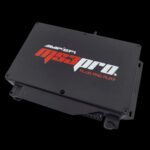For car enthusiasts and everyday drivers alike, understanding what’s happening under the hood has never been more accessible. Thanks to the advent of affordable OBD2 scanners, diving into your vehicle’s diagnostics is no longer exclusive to professional mechanics. If you’ve been wondering whether a Cheap Obd2 Scanner can actually empower you to troubleshoot car issues at home, the answer might surprise you.
OBD-II, or On-Board Diagnostics II, is a standardized system that’s been mandatory in most cars sold in the USA since 1996. It essentially allows your car’s computer, the Engine Control Unit (ECU), to communicate diagnostic information about various systems within your vehicle. This information is accessible through a standardized 16-pin Diagnostic Link Connector (DLC), usually located under the dashboard. Traditionally, accessing this data required expensive, professional-grade scan tools. However, the game has changed with the arrival of cheap OBD2 scanners, particularly Bluetooth-enabled adapters.
These budget-friendly devices, often based on the ELM327 chip, plug directly into your car’s OBD2 port and wirelessly connect to your smartphone or tablet via Bluetooth. This eliminates the need for bulky scan tools and cumbersome cables, offering a convenient and portable diagnostic solution. Don’t let the “cheap” price tag fool you; these scanners can be surprisingly powerful for basic diagnostics and vehicle monitoring.
The beauty of cheap OBD2 scanners lies in their compatibility with a wide range of OBD2 protocols, including ISO9141-2, a European standard also fully compliant with OBD-II. While some newer protocols boast faster data transfer rates, the fundamental communication with diagnostic tools remains consistent across the board. This means even a cheap scanner can effectively retrieve crucial data from your ECU.
So, what can a cheap OBD2 scanner actually do? For starters, they allow you to read Diagnostic Trouble Codes (DTCs). When your car’s “check engine light” illuminates, it signifies that the ECU has detected an issue and stored a DTC. A cheap OBD2 scanner, paired with a compatible app on your phone, can read these codes, giving you a starting point for diagnosing the problem. Many apps will even provide a description of the code, helping you understand what system is affected, whether it’s related to the engine, transmission, emissions, or other components.
Beyond just reading codes, many cheap OBD2 scanners and their accompanying apps offer real-time data monitoring. This means you can view live parameters from your engine and other systems as you drive. Commonly monitored parameters, also known as Parameter IDs (PIDs), include:
- RPM (Revolutions Per Minute): Engine speed.
- MPH (Miles Per Hour): Vehicle speed.
- TPS (Throttle Position Sensor): Throttle valve opening percentage.
- MAP (Manifold Absolute Pressure): Pressure in the intake manifold.
- MAF (Mass Air Flow): Amount of air entering the engine.
- O2 Sensors: Oxygen sensor readings, crucial for fuel mixture analysis.
- Ignition Timing Advance: Timing of the spark plug ignition.
- Calculated Load: Engine load percentage.
- Battery Voltage: Vehicle’s battery voltage.
By monitoring these parameters, you can gain valuable insights into your engine’s performance and identify potential issues before they escalate. For instance, noticing unusual readings from your oxygen sensors could indicate a problem with your catalytic converter or fuel system. Furthermore, many apps allow you to create custom dashboards, displaying the PIDs that are most relevant to you in digital or analog gauges, providing a real-time view of your car’s vital signs.
While cheap OBD2 scanners excel at reading codes and monitoring data, it’s important to understand their limitations. Generally, they are not designed for advanced functions like ECU remapping or bidirectional controls (e.g., commanding specific actuators). For tasks like ECU remapping, tools like TuneECU, often used for motorcycles and some cars, are necessary and typically require a wired OBD2 adapter with an FTDI chip for PC connectivity.
However, for the vast majority of DIY car owners and enthusiasts, a cheap OBD2 scanner offers incredible value. Imagine being able to quickly diagnose a check engine light yourself, potentially saving a trip to the mechanic for a simple code reading. Or picture monitoring your engine’s performance in real-time, gaining a deeper understanding of how your vehicle operates.
Several excellent and free or low-cost apps are compatible with cheap OBD2 scanners, further enhancing their functionality. Popular choices include:
- OBD Fusion: A feature-rich app known for its comprehensive diagnostics and customization options.
- Torque Pro: A favorite among enthusiasts, offering a wide array of gauges, data logging, and performance monitoring tools.
- DashCommand: Another robust app with customizable dashboards and advanced diagnostic features.
- OBD Car Doctor: A user-friendly app focusing on ease of use and clear fault code descriptions.
For users of specific vehicle brands or software, it’s also worth checking for compatibility. For example, the original article mentions TuneECU (Android version) working with the KONNWEI BT adapter for certain motorcycles, showcasing the versatility of these cheap scanners.
In conclusion, if you’re looking for an affordable entry point into DIY car diagnostics, a cheap OBD2 scanner is an excellent investment. For under $20, you can acquire a tool that empowers you to read trouble codes, monitor real-time data, and gain a deeper understanding of your vehicle’s health. While they may not replace professional-grade equipment for complex repairs, cheap OBD2 scanners are invaluable for everyday diagnostics, preventative maintenance, and satisfying your curiosity about what’s happening under your car’s hood. Start exploring the world of DIY car diagnostics today with a cheap OBD2 scanner and unlock a new level of automotive understanding.
